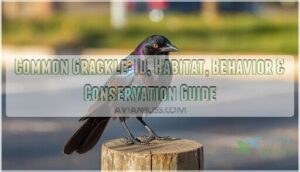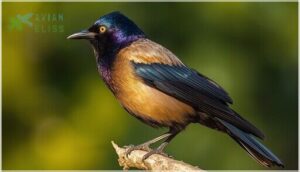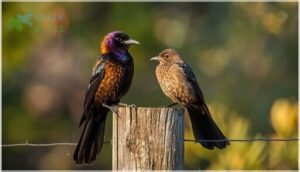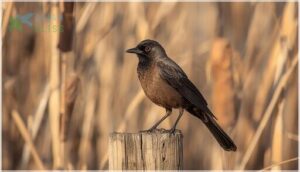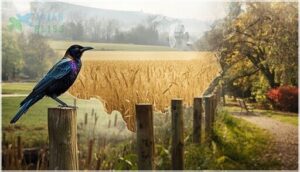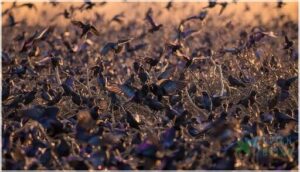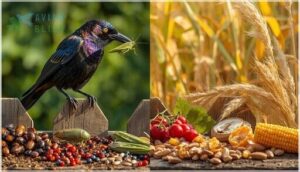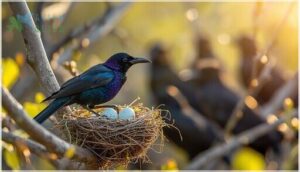This site is supported by our readers. We may earn a commission, at no cost to you, if you purchase through links.
You might mistake a common grackle for just another blackbird until sunlight hits its feathers and reveals something unexpected—a shimmering cascade of purple and bronze that transforms the ordinary into the remarkable.
These medium-sized birds, stretching 11 to 13 inches from bill to tail, possess an iridescence that rivals any tropical species, yet they thrive in parking lots and farm fields across North America. Their pale yellow eyes give them an almost alien appearance, while their keel-shaped tails and confident swagger distinguish them from their plainer cousins.
Understanding how to identify grackles, where they live, and why their populations are shifting helps you appreciate these glossy opportunists that have mastered the art of living alongside humans.
Table Of Contents
- Key Takeaways
- Common Grackle Identification
- Habitat and Geographic Range
- Behavior and Social Structure
- Diet and Feeding Habits
- Breeding, Nesting, and Conservation
- Frequently Asked Questions (FAQs)
- Are grackles good for your yard?
- What does it mean when you see a Common Grackle?
- Why are there so many grackles in my yard?
- Are grackles a nuisance bird?
- Do grackles scare away other birds?
- Is a grackle a type of crow?
- How do grackles use magnetite for navigation?
- What substances do grackles use for anting behavior?
- How long do Common Grackle nestlings stay in the nest?
- Can grackles mimic sounds or human speech?
- Conclusion
Key Takeaways
- Common grackles are medium-sized birds (11-13 inches) with striking iridescent purple-and-bronze plumage and pale yellow eyes, thriving in diverse habitats from urban parking lots to farm fields across eastern North America.
- These highly social, omnivorous birds form massive flocks—sometimes exceeding 100,000 individuals—and demonstrate remarkable adaptability by shifting their diet seasonally between insects, seeds, grains, and even scavenged food.
- Despite their current population of 69-97 million, common grackles have declined by roughly 60% over recent decades and now hold Near Threatened status due to habitat loss, pesticide use, and climate change.
- While grackles provide valuable pest control by consuming beetles and grasshoppers, their aggressive behavior at feeders, large communal roosts, and agricultural crop damage have earned them a nuisance reputation in human-dominated landscapes.
Common Grackle Identification
You’ll recognize a common grackle by its striking iridescence and bold presence, but knowing exactly what to look for makes all the difference.
The variations between males, females, and juveniles can be subtle yet significant when you’re trying to confirm an identification in the field. Let’s break down the key features that’ll help you spot these distinctive birds with confidence.
Physical Characteristics and Plumage
You’ll notice common grackles shimmer with iridescence patterns that shift from purple to bronze as they move through sunlight. These medium-sized birds stretch 11 to 13 inches long with distinctively glossy blue-black head feathers displaying purple sheen, while their bodies gleam with bronze sheen. Look for their pale yellow eyes, dark beak coloration, and keel-shaped tails—features that separate them from plain blackbirds in your backyard.
The common grackle’s physical characteristics, including its size and plumage coloration details, are essential for identification.
Male Vs. Female Differences
Sexual size dimorphism separates male grackles from females in several ways. Adult males weigh about 122 grams—roughly 23% heavier than females’ 94 grams—and stretch longer from bill to tail.
You’ll spot males by their intensely iridescent purple heads and bronze bodies, whereas females appear duller and browner. Males also show off elongated tails during courtship displays, while females keep shorter, understated tail feathers.
This phenomenon is similar to the concept of sexual dichromatism studies that are used to understand bird behavior.
Juvenile Features
You’ll find juvenile common grackles easy to distinguish from adults by their uniform brown plumage—no glossy sheen yet. They also keep dark brown eyes, unlike the pale yellow eyes of adults, making eye color a reliable field mark during bird species identification.
These youngsters maintain similar beak shape and size, but their shorter, sometimes ragged tails during the fledgling stage reveal their age before the first molting patterns begin.
Habitat and Geographic Range
You’ll find common grackles just about anywhere east of the Rockies, from bustling city parks to quiet farm fields. These adaptable birds don’t stick to one type of landscape—they’ve learned to make themselves at home in nearly every environment they encounter.
Let’s look at where you’re most likely to spot them, how their range spreads across the continent, and what drives their seasonal movements.
Preferred Environments
Common grackles thrive where you’ll find a patchwork of open ground and scattered trees—think agricultural areas edged by forest, wetland habitats fringed with cattails, and urban landscapes dotted with parks. These birds rarely venture into deep, unbroken forest.
Instead, they favor riparian zones, croplands, and suburban yards where avian ecology meets human activity, maintaining ecological balance across diverse common grackle habitat.
Regional Distribution in North America
Across North America, you’ll encounter the Common Grackle’s breeding range stretching from the Atlantic Coast to the Rocky Mountains, with strongholds in the East and Midwest. Regional variations in population trends reveal where these birds thrive:
- Eastern Tallgrass Prairie and Corn Belt – Breeding densities exceed 120 grackles per survey route, reflecting prime habitat preferences.
- Southern Canada – Common to very common across agricultural provinces from Saskatchewan to the Maritimes.
- Southeastern U.S. – Year-round residents maintain stable populations along the Gulf Coast and Mississippi Valley.
Seasonal Movements and Migration
When fall arrives, you’ll witness northern populations streaming south from Canada and upper U.S. states, with migration patterns peaking in October. Spring migration timing begins as early as February, bringing birds back to breeding range by late March.
Southern grackles skip the journey entirely, staying year-round while hosting massive winter roosts where flocks exceeding one million birds gather in mixed-species congregations.
Behavior and Social Structure
Common grackles aren’t solitary birds—they’re social creatures that live life in groups, often forming flocks that number in the hundreds or even thousands. Their behavior reflects a constant balance between cooperation and competition, especially regarding food and nesting territories.
Understanding how these birds communicate, roost, and interact with their feathered neighbors gives you a clearer picture of their daily rhythms and survival strategies.
Flocking and Roosting Patterns
You’ll notice Common Grackles transform from scattered pairs into massive traveling groups once breeding season ends. Their social structure revolves around communal roosts that showcase impressive bird behavior and migration patterns:
- Fall roost peaks can exceed 100,000 grackles at single sites during October–November
- Winter flocking brings mixed-species groups with tens of thousands of individuals
- Breeding colonies usually host 20–30 pairs in localized clusters
- Daily commutes connect feeding grounds to roost sites several kilometers away
- Flock dynamics shift seasonally from dispersed territories to dense communal roosts
Vocalizations and Communication
You’ll hear Common Grackles long before you see them—their song patterns include the signature “readle-eak” lasting about one second, packed with harsh notes hitting 1.5 to 5 kHz. Males belt out these acoustic signals during breeding season, while both sexes share several call types: sharp “chack” notes for flock cohesion, squeaks, whistles, and guttural croaks that shift with social context.
Interactions With Other Birds
You’ll witness plenty of agonistic behavior when grackles share space with other species—they regularly push House Sparrows and Robins away from feeders, forming mixed flocks with European starlings and American Crows where social hierarchy becomes obvious.
Birders often notice interspecies conflict around nesting sites, where grackles compete for prime real estate. Their flock dynamics shift constantly as these birds navigate the pecking order with intimidation displays rather than outright fights.
Diet and Feeding Habits
Common grackles aren’t picky eaters—they’ll consume just about anything they can get their beaks on. Their diet shifts with the seasons, balancing protein-rich insects in warmer months with seeds and grains when temperatures drop.
Let’s break down what these opportunistic feeders eat and how they find their meals throughout the year.
Omnivorous Diet Composition
You’re looking at one of nature’s true generalists regarding avian diet. Common grackles split their omnivorous intake between plant and animal matter, with seasonal shifts driving food sources.
During breeding season, insect prey—beetles, caterpillars, and spiders—can comprise 25% or more of their diet, while seed consumption and agricultural grains dominate in fall and winter, reflecting adaptive feeding behavior.
Foraging Techniques and Food Sources
You’ll see grackles walking across lawns, probing for earthworms and beetles through ground foraging, or wading at wetland edges to snatch tadpoles and crayfish—classic omnivorous feeding behavior.
They don’t stop there. These opportunists practice aerial feeding by sallying for airborne insects, raid other birds’ nests for eggs, and aren’t shy about scavenging garbage or committing food piracy at backyard feeders.
Seasonal Dietary Changes
Where grackles find food changes dramatically with the calendar. Their omnivorous adaptability shines through distinct seasonal patterns:
- Spring and summer – Insect intake surges as breeding adults hunt beetle larvae, grasshoppers, and caterpillars to feed nestlings, with invertebrates comprising 25% or more of the diet.
- Autumn – Grain consumption peaks when flocks descend on harvested cornfields for spilled kernels and acorns.
- Winter – Seed reliance dominates as natural prey vanishes; waste grain and sunflower seeds sustain populations.
- Late summer – Fruit eating intensifies on ripening grapes and berries.
This flexible winter foraging strategy explains why you’ll spot them raiding feeders when temperatures drop and snow limits access to natural foods.
Breeding, Nesting, and Conservation
When spring arrives, common grackles shift their focus to reproduction, gathering in noisy colonies where courtship displays and nest-building take center stage. Understanding their breeding habits gives you insight into their survival strategies, while their conservation status tells a more troubling story about population decline.
Here’s what you need to know about how these birds raise their young and the challenges threatening their future.
Mating and Courtship Behaviors
Pair formation kicks off in early spring when males outnumber females by two or three to one, launching dramatic aerial chases where males trail behind with tails angled into a deep V-shape.
You’ll spot courtship displays as males fluff their feathers and lift their wings while females respond with their own calls.
Mate guarding continues through incubation, with males staying close to their partners throughout breeding.
Nest Construction and Egg Laying
Once paired, the female gets to work building a bulky nest from twigs and coarse plant material, often in a conifer or shade tree near water. She lines it with mud and fine grasses, taking about 11 days to finish.
You’ll usually find a clutch of 4 to 6 pale blue eggs with dark scrawls, which she’ll incubate alone for 12 to 14 days.
Conservation Status and Population Threats
Despite still numbering around 69 to 97 million individuals, you’re witnessing a species in serious trouble. The common grackle is now classified as Near Threatened, having declined by roughly 60% over recent decades.
The common grackle, despite its large population, has declined 60% and now faces Near Threatened status
Habitat loss, climate change, and pesticide use drive these population declines, while lethal control programs targeting agricultural pests add pressure.
Wildlife conservation efforts must address these threats to prevent further species decline and support biodiversity conservation.
Human Impact and Protection Efforts
Beyond recognizing the threats grackles face, you can contribute to solutions that balance human needs with avian ecology. Wildlife conservation demands thoughtful approaches:
- Habitat Modification – preserving nesting sites and natural corridors fosters biodiversity conservation.
- Pesticide Reduction – limiting chemical use protects both birds and ecosystem services.
- Urban Planning – designing bird-friendly spaces reduces environmental impact.
- Nonlethal Dispersal – using frightening techniques prevents damage without killing.
- Habitat Preservation – maintaining wetlands and woodlots ensures population stability.
Frequently Asked Questions (FAQs)
Are grackles good for your yard?
Like a coin with two faces, grackles offer pest control benefits—consuming beetles, grasshoppers, and grubs—yet their aggressive bird behavior, seed waste, and droppings can challenge yard management and eco balance at feeders.
What does it mean when you see a Common Grackle?
Seeing a Common Grackle usually signals healthy, diverse habitat nearby—not spiritual symbolism or bird omens.
Wildlife encounters with these birds indicate abundant food sources, suitable nesting areas, and thriving ecosystems where nature signs point toward environmental stability.
Why are there so many grackles in my yard?
Your yard likely draws grackles because of abundant food at bird feeders, open lawns rich in insects, nearby water sources, and shelter from trees—all supporting their Flocking Behavior and communal Roosting Sites in Urban Habitats.
Are grackles a nuisance bird?
Yes, grackles earn their nuisance reputation. You’ll encounter crop damage, urban roosting chaos, and noise pollution from massive flocks.
Their droppings create health hazards while they aggressively dominate feeders, though conservation concerns temper control efforts.
Do grackles scare away other birds?
Yes, grackles do scare away other birds through feeder dominance and aggressive behavior. Their flock intimidation tactics cause bird displacement, with studies showing they direct over 50% of attacks toward other species, leading to species exclusion at feeding sites.
Is a grackle a type of crow?
No, grackles aren’t crows. Despite bird misidentification from a distance, these species belong to different families—Icteridae versus Corvidae.
You’ll spot the distinction through taxonomic differences: grackles feature iridescent feathers and yellow eyes, while crows are uniformly black.
How do grackles use magnetite for navigation?
You know what they say—nature finds a way. Magnetite-based avian magnetoreception helps many migratory birds detect geomagnetic fields for navigation.
However, specific evidence confirming this mechanism in Common Grackles remains scientifically unverified.
What substances do grackles use for anting behavior?
During anting, you’ll see these birds using formic acid from live ants, citrus peels, naphthalene from mothballs, aromatic flowers like marigolds, and various plant extracts—substances that affect ectoparasites on their feathers.
How long do Common Grackle nestlings stay in the nest?
Young birds usually leave the nest about 10 to 17 days after hatching, with most fledging around the two-week mark. This nestling duration follows a 12-14 day incubation period, resulting in roughly four weeks from egg-laying to nest departure.
Can grackles mimic sounds or human speech?
Yes, these birds can mimic sounds. Common Grackle vocalizations include bird calls and environmental noises like machinery.
While vocal imitation of human speech occurs occasionally in captivity, sound mimicry is less precise than specialist mimics.
Conclusion
Think of the common grackle as nature’s contradiction—a bird that wears elegance like armor while scavenging parking lots with the confidence of a conqueror.
You’ve learned to recognize their iridescent plumage, decode their raucous calls, and understand why their numbers are quietly declining.
Now, when you spot that distinctive silhouette with its keel-shaped tail cutting across the sky, you won’t see just another blackbird—you’ll recognize a survivor adapting to a world we’ve reshaped.

